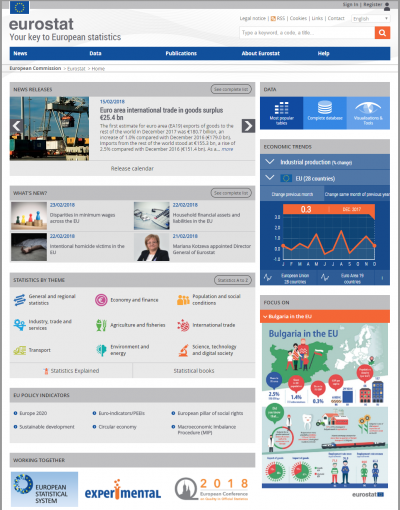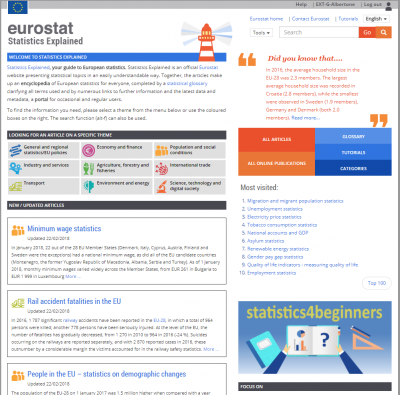Archive:Being young in Europe today - introduction
This is one of a set of statistical articles that forms Eurostat’s flagship publication Being young in Europe today.
A paper edition of the publication was also published in 2015. In late 2017, a decision was taken to update the online version of the publication (subject to data availability).
Full article
About this publication
In late 2013, Eurostat introduced a new type of publication, the ‘flagship publication’, with the aim of providing statistical analyses related to important social, economic or environmental phenomena. The goal for these publications was to address specific themes highly relevant for the general public and European Union (EU) policymaking.
Being young in Europe today is part of this breed of publications and presents some of Eurostat’s most interesting data on the state of the population of younger people in the EU today. Being young in Europe today does not claim to be an exhaustive publication, but it provides an overview of the wealth of information that is available on Eurostat’s website and within its online databases. It provides a balanced set of indicators, with a broad cross-section of information.
What can you find in this publication?
Being young in Europe today is divided into seven chapters covering population, family and society, health, education, access and participation to the labour market, living conditions and the digital world.
Each chapter contains data and background information relating to a very wide range of European statistics. More information can be found on Eurostat’s website, which contains subject-specific publications and online databases.
Infographic ‘Young Europeans’
To complement this publication on children and young people, Eurostat has developed an infographic that provides information to young internet users in a fun way. The infographic covers four main areas: family, work, free time and studies, and the internet. The infographic can be accessed through the homepage of Eurostat’s website.
About initiatives from the European Union
The EU has set up several initiatives to either provide information about all policies that can help strengthen the capacities of children and their families or promote dialogue between the population of younger people and policymakers.
The European Platform for Investing in Children (EPIC)
In February 2013, the European Commission (EC) adopted the Recommendation 2013/112/EU of 20 February 2013 ‘Investing in Children — breaking the cycle of disadvantage’ as part of the Social Investment Package, which proposed a long-term social strategy to support children and to help mitigate the effects of the economic crisis. The Recommendation provides guidance for EU Member States on how to tackle child poverty and social exclusion through measures such as family support and benefits, quality childcare and early-childhood education. Social investment in individual capacities during early years is particularly beneficial for children from a disadvantaged background and can provide large social returns. Such investment is also considered a crucial factor in breaking cycles of intergenerational transmission of poverty.
The European Platform for Investing in Children (EPIC) is an evidence-based online platform that provides information about policies that can help children and their families face the challenges that exist in the current economic climate. It also helps EU Member States implement the Recommendation. This platform is used to collect and disseminate innovative practices that have a positive impact on children and families in EU Member States.
The EU’s Youth Strategy
In 2009, the European Council adopted Resolution 2009/C 311/01 on a renewed framework for European cooperation in the youth field (2010-2018), which set the stage for the EU’s Youth Strategy. The Resolution was the outcome of the European Commission’s efforts to promote dialogue between the population of younger people in the EU and policymakers, with the aim of increasing active citizenship, fostering social integration, and ensuring the inclusion of the young in EU policy development.
The EU Youth Strategy for 2010-2018 pursues two overall objectives:
- to provide more and equal opportunities for young people in education and in the job market; and
- to encourage young people to actively participate in society.
To achieve these objectives it proposes initiatives in eight fields:
- education and training;
- employment and entrepreneurship;
- health and well-being;
- participation;
- voluntary activities;
- social inclusion;
- youth and the world; and
- creativity and culture.
The first three years of the EU’s Youth Strategy (2010-2012) were jointly assessed by the European Commission and the European Council in the EU Youth Report 2012. For the period 2013-2015, three top priorities were put forward:
- employment;
- social inclusion (particularly for people with fewer opportunities); and
- health and well-being.
The 2015 EU Youth Report was published in September 2015 and presents a picture of the situation of young people in Europe and how policymakers have addressed it in the period 2013-2015. For the period 2016-2018, the following priorities were identified:
- increased social inclusion of all young people, especially those at risk such as NEETs and young people with a migrant background;
- stronger participation of all young people, in particular those at risk of marginalisation;
- easier integration into the labour market for all young people, with a special focus on the long-term unemployed and those in transition from education to work.
In December 2016, the European Commission proposed in a Communication Investing in Europe’s Youth a renewed effort to support young people through three strands of action, to promote better opportunities:
- to access employment,
- through education and training,
- for solidarity, learning mobility and participation.
About Eurostat and European statistics
Eurostat is the statistical office of the EU, situated in Luxembourg. Its task is to provide European statistics that enable comparisons between countries and regions. Eurostat’s mission is to be the leading provider of high-quality statistics on Europe.
Accessing European statistics
The simplest way to access Eurostat’s broad range of statistical information is through its website (http://ec.europa.eu/eurostat). Eurostat provides users with free access to its databases and all of its publications in portable document format (PDF) via the internet. The website is updated daily and gives access to the latest and most comprehensive statistical information available on the EU, its Member States, EFTA countries, as well as enlargement countries.
Eurostat online data codes — easy access to the freshest data
Eurostat online data codes allow easy access to the most recent data on Eurostat’s website. In this publication the online data codes are given as part of the source below each table and figure. Online data codes lead to either a two- or three-dimensional table in the TGM (tables, graphs, maps) interface or to an open dataset which generally contains more dimensions and longer time series using the Data Explorer interface.
Online data codes can also be fed into the ‘Search’ function on Eurostat’s website. The results from such a search present related dataset(s) and possibly publication(s) and metadata.
Note that the data on the Eurostat’s website are frequently updated and that the description above presents the situation as of January 2018.
Statistics Explained
Statistics Explained is part of Eurostat’s website. It provides easy access to statistical information concerning the EU.
Statistics Explained is an online publishing system about EU statistics which uses MediaWiki technology and resembles Wikipedia. This wiki-based system presents statistical articles which together form an encyclopaedia of European statistics, completed by a glossary of the statistical concepts and terms used. In addition, numerous links to the latest data and metadata as well as to further information are provided, making Statistics Explained a portal for regular and occasional users alike.
It is possible to search for articles using the ‘Search’ function on the top-right of each Statistics Explained webpage, or to get a PDF version of the article, to print, to bookmark or forward content easily.
Direct access to
<database>
- LFS series - Specific topics (lfst)
- Youth (yth), see:
- Youth population (yth_demo)


